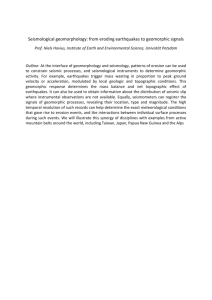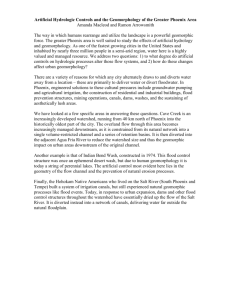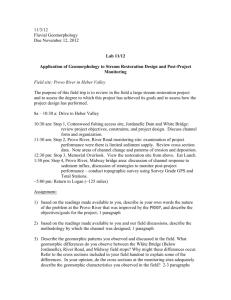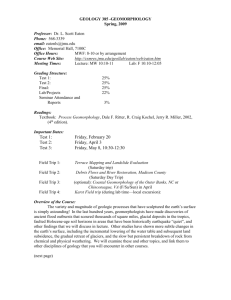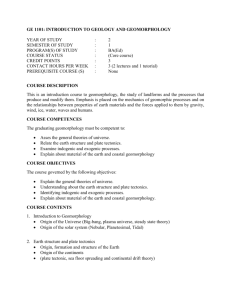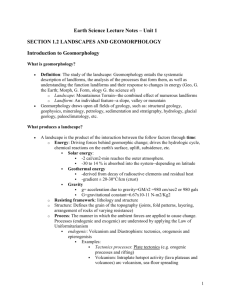GIS-enhanced geomorphology labs for undergraduate geology and
advertisement
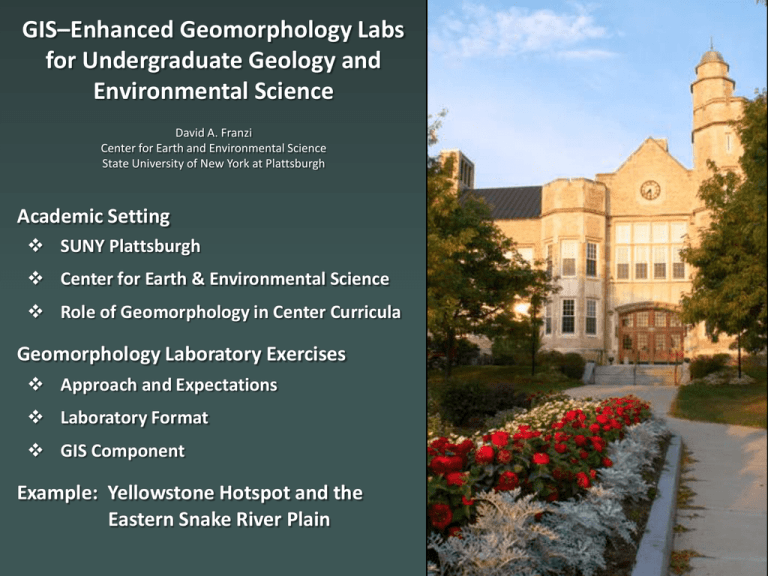
GIS–Enhanced Geomorphology Labs for Undergraduate Geology and Environmental Science David A. Franzi Center for Earth and Environmental Science State University of New York at Plattsburgh Academic Setting SUNY Plattsburgh Center for Earth & Environmental Science Role of Geomorphology in Center Curricula Geomorphology Laboratory Exercises Approach and Expectations Laboratory Format GIS Component Example: Yellowstone Hotspot and the Eastern Snake River Plain Academic Setting SUNY Plattsburgh One of thirteen four-year liberal arts colleges in the State University of New York System Location Map 74o ON PQ Plattsburgh Offers more than 60 major programs 72o Montreal ME VT Enrolls approximately 5,700 students 44o NH NY Boston MA 42o CT RI PA NJ New York 0 100 km Academic Setting Center for Earth and Environmental Science CEES Majors Created in 1982 by merging the Geology, Environmental Science and Geography Programs 140 120 Currently serves more than 230 majors Undergraduate Degree Programs → BA, BS Geology → BA Environmental Geology → BA Earth Science → BA, BS Environmental Science Headcount (2014) 100 80 60 40 → BA Environmental Planning & Management → BS Ecology → BA Environmental Studies 20 0 ENV SCI ECOLOGY GEOLOGY STUDIES Academic Setting Role of Geomorphology in the CEES Curricula Required for BS Environmental Science Elective class for BA, BS Geology; BA Earth Science; BA Environmental Geology; BA Environmental Science; BA Environmental Planning and Management; BS Ecology Not listed as a required or elective course in the BA Environmental Studies program Course Details Audience: sophomore to junior level Enrollment: ≈20 students (60‒65% environmental science; 35‒40% geology) Frequency: every semester Geomorphology Laboratory Exercises Approach: Combine traditional topographic map and aerial image analysis and GIS technology with process-oriented regional geomorphology Expectations: By the end of the semester students will be expected to: Recognize the geomorphology of the major physiographic regions in the US Use GIS technology to; → Find sources or create new spatial databases for use with GIS software; → Extract morphometric data from GIS databases to measure linear dimensions, areas, volumes, elevation, relief and slope of landforms; → Construct topographic and shaded relief maps; → Construct topographic profiles and determine vertical exaggeration; → Export data from GIS databases for analysis by other analytical software (e.g. spreadsheets, visualization or modelling software); → Create accurate and effective graphics for presentations or final reports. Effectively communicate their understanding of geomorphic features and processes Geomorphology Laboratory Exercises Laboratory Format (report template provided) Introduction Literature Review Students address questions that are designed to review basic concepts and terminology and reinforce their understanding of the geologic setting and geomorphic evolution of the subject landscape. Geomorphic Analysis (Greek: analuein → unloose, break apart) This section examines specific landforms or landscapes in the study region. Students are evaluated on the overall quality of their responses as demonstrated by their level of preparation (literature review), breadth of comprehension and the quality of the graphic elements. Landform Analysis Geomorphic Synthesis (Greek: suntithenai → to place together) Students bring together data from multiple landform analyses and answer questions that address geomorphic system function and landscape evolution. Concept Model Geomorphology Laboratory Exercises GIS Component The Challenge To introduce and use GIS technology as a tool to enhance understanding of geomorphological principles and concepts without becoming a GIS course Considerations → Recognize the diversity of students’ academic backgrounds and experience; → Provide subject material that is interesting and relevant to a diverse audience; → Establish reasonable expectations and communicate them clearly to the students at the onset of the exercise → Provide an organized template for reporting that guides students through the exercise Geomorphology Laboratory Exercises GIS Advantages Many useful applications can be performed with minimal prior GIS experience; Mitigates time lost due to repetitive and mundane or time-consuming tasks; Allows the student to work effectively at different spatial scales, thus enabling the student to observe the fine details of individual landforms and develop a synoptic understanding, both temporally and spatially, of the landscape; Geospatial data are easily exported for use by other analytical or presentation software; Facilitates application of simple mathematical models. Geomorphology Laboratory Exercises 2014 Laboratory Exercises Introduction to topographic maps, Geographic Information Systems and Physiographic Regions of the US Geomorphological Content review topographic map analysis skills, geology and physiography Piedmont Landscapes of the Basin and Range piedmont landforms, stream capture, supply-limited and transportlimited fluvial systems, effects of climate change, relict landforms, landscape evolution The Nevadaplano and Origin of the Basin and Range Cenozoic tectonics in the western US, crustal delamination, crustal extension and isostatic response, inverted topography The Yellowstone Hotspot and Eastern Snake River Plain hotspot tectonics, phreatomagmatic eruptions, maar-diatreme pyroclastic cones, flood basalts, calderas, isostatic adjustments, fluvial drainage patterns, eolian dune classification, response of fluvial and eolian systems to climate change The Colorado Plateau; Grand Canyon, Monument Valley and Arches Cenozoic tectonics in the western US, crustal delamination, isostatic adjustments, salt tectonics, foreland basins, inverted topography Mammoth Cave and the Interior Low Plateaus karst landforms, origin of caves, karst hydrology, entrenched rivers, foreland basins, sinking streams, stream networks and drainage density Morphometry of Watersheds in the Appalachian Plateau watershed delineation, network topology, hypsometry, entrenched rivers, stream piracy, landscape evolution Geomorphology of the Eastern Snake River Plain Introduction Physiographic setting of the Eastern Snake River Plain; Hotspot tectonics, isostatic adjustments and climate change; Phreatomagmatic eruptions. Climate System Controls Tectonics Gravity Map showing the northeastward apparent motion of hotspot migration and the ages of the various calderas (Modified from; Barenek et al., 2006; Link et al., 1992; Pierce and Morgan, 1992). Geomorphology of the Eastern Snake River Plain Geomorphic Analysis 112o W Menan Buttes → Morphology of maar-diatreme cones → Volume of pyroclastic ejecta 44o N St. Anthony Dune Field Fluvial Geomorphology → Regional Drainage Network Patterns → Channel pattern, sinuosity and stream gradient St. Anthony Dune Field Menan Buttes → Dune classification → Composition and provenance → Relict dunes → Loess The Eastern Snake River Plain. NASA Earth Observatory image created by Jesse Allen and Robert Simmon, using EO-1 ALI data provided courtesy of the NASA EO-1 team. Geomorphic Analysis – Example Data Menan Buttes ‒ Controls on Pyroclastic Cone Morphology Map and Data from: P. Montouri, GEL 341, 2014) Geomorphic Analysis – Example Data Menan Buttes ‒ Ejecta Volume The volume of a maar frustrum (including the crater volume) is given by the equation; 𝑽𝒎 = 𝟏 𝛑𝑯𝒎 (𝑹𝟐𝟏 + 𝑹𝟏 𝑹𝟐 + 𝑹𝟐𝟐 ) 𝟑 And the volume of the crater frustrum is given by the equation; 𝟏 𝟑 𝑽𝒄 = 𝛑𝑯𝒄 (𝑹𝟐𝟐 + 𝑹𝟐 𝑹𝟑 + 𝑹𝟐𝟑 ) where R1, R2 and R3 are the average radii of the upper and lower surfaces of each frustrum and Hm and Hc are the heights of the maar and crater frustra, respectively. The volume of the pyroclastic material that comprises the buttes is the difference between the maar and crater frustra; 𝐕 = 𝐕𝐦 − 𝑽𝒄 Data from: P. Montouri, GEL 341, 2014) Figure 6. Variables used to calculate the volume of pyroclastic material in the Menan Buttes. Sato and Taniguchi (1997) equation: D = 0.97V0.36 Where D = average cone diameter. Table 2. Estimates of the volume of pyroclastic material in the Menan Buttes. Cone Volume (measured) Cone Volume (estimated from Sato and Taniguchi (1997) equation) North Menan Butte 9.29 x 108 m3 2.16 x 108 m3 South Menan Butte 3.80 x 108 m3 2.50 x 108 m3 Geomorphology of the Eastern Snake River Plain Geomorphic Analysis – Example Data Controls on Regional Drainage Patterns St.Anthony Dunes Snake River: Network: Distributary (alluvial fan) and Anabranching (to south) Teton River Network: Distributary (alluvial fan) and Anabranching (near Henry’s Fork) Henry’s Fork: Network: Anabranching and Agricultural Menan Buttes Eastern Uplands: Network: Dendritic Northwest of Menan Buttes: Network: none (Map from H. Affinati, GEL341, 2014) Geomorphology of the Eastern Snake River Plain Geomorphic Analysis St. Anthony Dune Field → Effects of wind direction and sediment supply → Relict dunes and climate change Geomorphology of the Eastern Snake River Plain 112o W Geomorphic Synthesis Geological context for Cenozoic eruptions Eruptive energy of maar-diatreme volcanoes 44o N St. Anthony Dune Field Tectonic, isostatic and climate controls on channel and drainage network patterns Effects of climate change on fluvial and eolian systems Menan Buttes The Eastern Snake River Plain. NASA Earth Observatory image created by Jesse Allen and Robert Simmon, using EO-1 ALI data provided courtesy of the NASA EO-1 team. Caption by Holli Riebeek with information from Idaho State University geologist, Paul Link. Summary Geomorphology Labs for Environmental Science and Geology Considerations and Points of Emphasis Analytical Skills: Provide relevant knowledge and skills to diverse student audience. → Traditional topographic map and aerial image interpretation → Introduction to GIS technology → Knowledge of Regional Geology (Ecoregions) of the United States → Effective communication Geomorphic Synthesis: Bring the pieces together → Temporal and spatial scales in geomorphology → Geomorphic Systems Approach → Response of Geomorphic Systems to changes in climate, tectonic or gravitational forcings Laboratory Outline and Key Topics and Concepts I. Introduction a. b. c. d. The Appalachian Foreland Basin Teays River Controls on limestone dissolution Karst landforms II. Geomorphic Analysis a. Surface and subterranean drainage systems III. Geomorphic Synthesis a. Vadose and phreatic groundwater flow pathways b. Drainage changes in the Green River basin c. Anthropogenic influences on karst ecosystems Map from: P. Montouri, GEL 341, 2014) Vertical exaggeration = 8x Topographic profile data from: P. Montouri, GEL 341, 2014) Sawtooth and Giant Mtns. From Allen Mtn. Photo: D. Franzi, 2009
